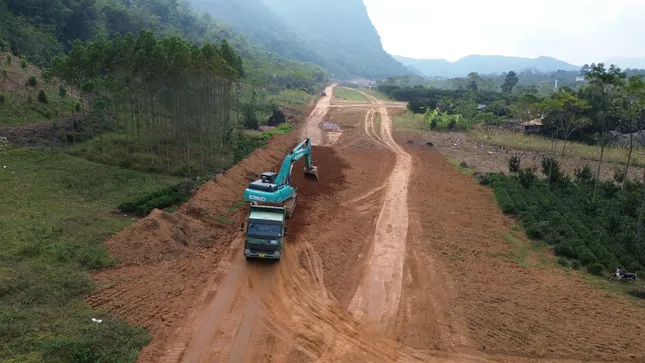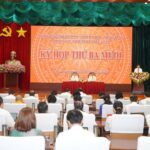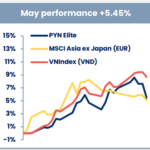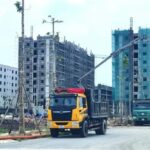In the first five months of the year, the disbursement of investment capital reached nearly VND 200,000 billion, equivalent to 24.1% of the plan assigned by the Prime Minister. The Ministry of Finance assessed that the disbursement progress has accelerated significantly, catching up with the pace of the same period last year.
However, among the central-level ministries and agencies, 37 out of 47, and among the provinces and cities, 24 out of 63, have a disbursement rate below the national average. Many have not disbursed or have very low disbursement rates, below 10%, including the Vietnam Academy of Science and Technology, the Ministry of Education and Training, the Ministry of Health, the Supreme People’s Court, the Ministry of Industry and Trade, the Ministry of Culture, Sports and Tourism, and the Committee for Religious and Ethnic Affairs.

The progress of public investment disbursement depends largely on land clearance. Illustration photo.
Seven localities had a disbursement rate below 15%, including Lai Chau, Binh Phuoc, Binh Duong, Cao Bang, Dong Nai, Phu Yen, and Ben Tre.
On the other hand, several central-level ministries and agencies have performed well, with a disbursement rate of over 30%, including the Vietnam General Confederation of Labour (86%), Voice of Vietnam (73%), Vietnam Bank for Social Policies (41%), and the Ministry of Public Security (40%).
The localities with a disbursement rate of over 40% include Phu Tho, Thanh Hoa, Lao Cai, Thai Nguyen, Nam Dinh, and Ha Giang.
To ensure the full disbursement of the public investment plan, the Ministry of Finance requested that ministries, sectors, and localities proactively implement various solutions in the context of administrative rearrangement and the implementation of a two-level local government model.
Localities need to review and adjust their capital plans accordingly. Continuous efforts are required in planning, appraisal, land clearance, construction, acceptance, and payment, without any disruptions. Legal documents must be handed over comprehensively and clearly, and project owners and management boards must coordinate closely with departments to ensure smooth disbursement.
The Ministry of Finance also emphasized the need to prioritize addressing land clearance issues, which is the biggest bottleneck hindering project progress. Localities must mobilize the involvement of leaders and the entire political system to resolve the “project awaiting land” situation.
For projects utilizing ODA capital, project owners should closely monitor progress and promptly handle any difficulties in project implementation and disbursement. They should focus on accelerating the disbursement of projects that have completed investment procedures, bidding, and contract signing.
Regarding local budget capital, the Ministry of Finance proposed accelerating budget collection, especially from land, to ensure timely capital allocation.
Priority should be given to key projects, especially in the transport sector, to complete at least 3,000 km of highways by 2025 and over 1,000 km of coastal roads in 2025. It is necessary to expedite the progress of important projects and large-scale constructions that meet the requirements.
The Ministry of Finance also requested that localities, ministries, and sectors develop monthly and quarterly disbursement plans and resolutely cut capital from slow-progress projects to reallocate to those with better performance.
At the recent conference on promoting the driving force of public investment growth, Prime Minister Pham Minh Chinh determined to disburse 100% of public investment capital in 2025 (the previous target was 95%). The Prime Minister emphasized that the disbursement results of public investment capital would be an important basis for evaluating task completion and assessing officials, and if the target is not achieved, there would be inspections and handling.
“Bà Rịa – Vũng Tàu: A Vision for Social Housing with 14,400 Homes”
The People’s Council of Ba Ria – Vung Tau Province has passed several important resolutions, including an ambitious goal for the development of over 14,400 social housing units by 2030. This significant target highlights the province’s commitment to addressing the housing needs of its residents and fostering a inclusive and thriving community.
The Slow and Steady Turtle: Navigating the Challenges of Public Investment Disbursement
The disbursement of public investment funds has seen a significant boost, with over 24% of the plan achieved in just 5 months. However, a large number of central agencies and local governments are falling behind, with their disbursement rates below the national average. In some cases, there has been little to no progress, with disbursement rates lingering below 10%.
The Power of Persuasive Writing: Crafting Compelling Headlines
Unleashing PYN Elite’s “Slow-Paced” Performance to Reach a 16-Month High
Despite lagging behind the robust growth of the VN-Index in May, PYN Elite Fund’s investment performance delivered the highest returns in 16 months since January 2024.
Is Public Investment the Key to Countering Tariff Challenges?
In the face of challenging US trade policies, experts and infrastructure businesses believe that public investment will be the key driver to sustain Vietnam’s economic growth. However, to achieve the desired goals, there is a need to create a ripple effect on private investment, FDI, and consumer spending.
Social Housing Credit: Fear of ‘Fizzling Out’ from One Package to the Next
The new credit package for young people under 35 years old to buy social housing, offered by 9 participating banks, is essentially no different from the VND 120,000 billion package currently being implemented, despite the longer incentive period. With interest rates still high and limited social housing supply, this package risks falling into the same pitfalls as its predecessor.





















